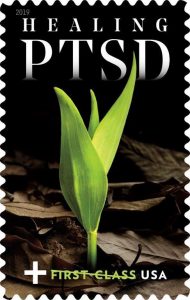New Postage Stamp: Healing PTSD
Today, Dec. 2, the U.S. Postal service begins selling a new stamp, the PTSD Healing stamp, that will help raise funds for people diagnosed with post-traumatic stress disorders (PTSD).
 The image of a green plant sprouting from the ground covered in fallen leaves symbolizes the PTSD healing process. The stamp was designed by Greg Breeding with original art by Mark Laita and will cost 65 cents. Revenue from sales of the stamp (less the first-class postage of 55 cents and reimbursement of costs to the Postal Service) will go to the U.S. Department of Veterans Affairs, which oversees the National Center for PTSD.
The image of a green plant sprouting from the ground covered in fallen leaves symbolizes the PTSD healing process. The stamp was designed by Greg Breeding with original art by Mark Laita and will cost 65 cents. Revenue from sales of the stamp (less the first-class postage of 55 cents and reimbursement of costs to the Postal Service) will go to the U.S. Department of Veterans Affairs, which oversees the National Center for PTSD.
The PTSD stamp is the third fundraising stamp issued by the US Postal Service. The first was the Breast Cancer Research stamp in 1998 and the second was the Alzheimer’s stamp in 2017. Future fundraising stamps have not been determined.
PTSD is a psychiatric disorder that can occur in people who have experienced or witnessed a traumatic event, such as a natural disaster, a serious accident, a terrorist act, war, rape or other violent personal assault. The exposure could be indirect rather than first-hand. For example, PTSD could occur in an individual learning about the violent death of a close family. PTSD was added to the Diagnostic and Statistical Manual of Mental Disorders (DSM) in 1980.
Many people experience trauma, and PTSD can happen to anyone. About 8 million adults have PTSD during a given year. About 60% of men and 50% of women experience at least one trauma in their lives. About 7-8% of people will have PTSD at some point in their lives, including about 10% of women and about 4% of men.
People with PTSD have intense, disturbing thoughts and feelings related to their experience that last long after the traumatic event has ended. They may relive the event through flashbacks or nightmares; they may feel sadness, fear or anger; and they may feel detached or estranged from other people. People with PTSD may avoid situations or people that remind them of the traumatic event, and they may have strong negative reactions or may startle easily at ordinary things, such as a loud noise or an accidental touch.
Many people who are exposed to a traumatic event experience symptoms in the days following the event. For a person to be diagnosed with PTSD, however, symptoms last for more than a month and cause significant distress or problems functioning.
Various research-proven methods are available to help people recover from PTSD. Psychotherapy, particularly several types of cognitive behavior therapies (CBT), are effective in treating PTSD. Cognitive processing therapy, prolonged exposure therapy and stress inoculation therapy are among the types of CBT used to treat PTSD. Medication can help to control the symptoms of PTSD. Many people with PTSD find being able to share their experiences and feelings with others who have similar experiences, such as in a peer support group, very helpful.
Other treatments, including complementary and alternative therapies, are also increasingly being used to help people with PTSD. These approaches provide treatment outside the conventional mental health clinic and may require less talking and disclosure than psychotherapy. Examples include acupuncture and animal-assisted therapy.
